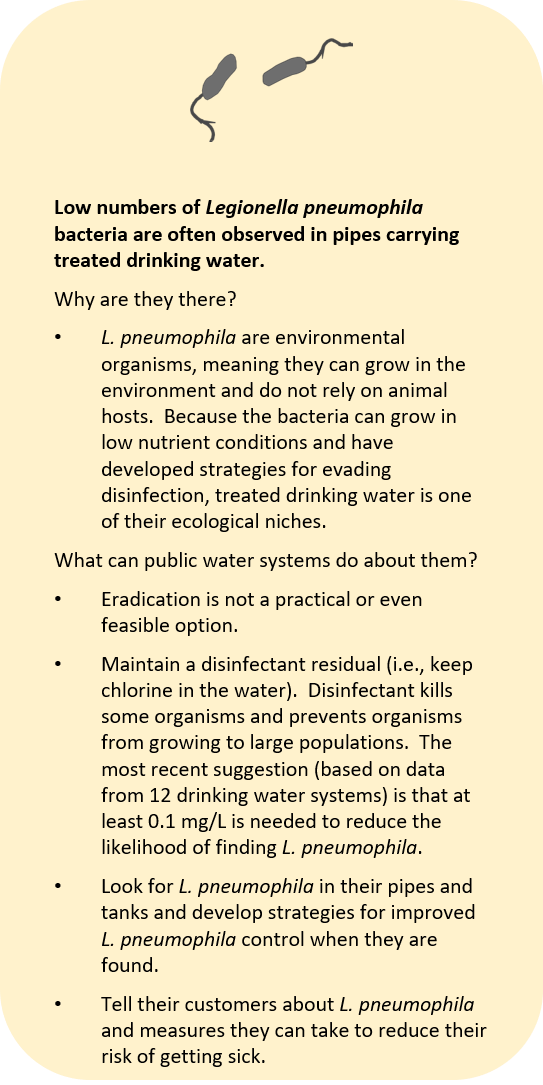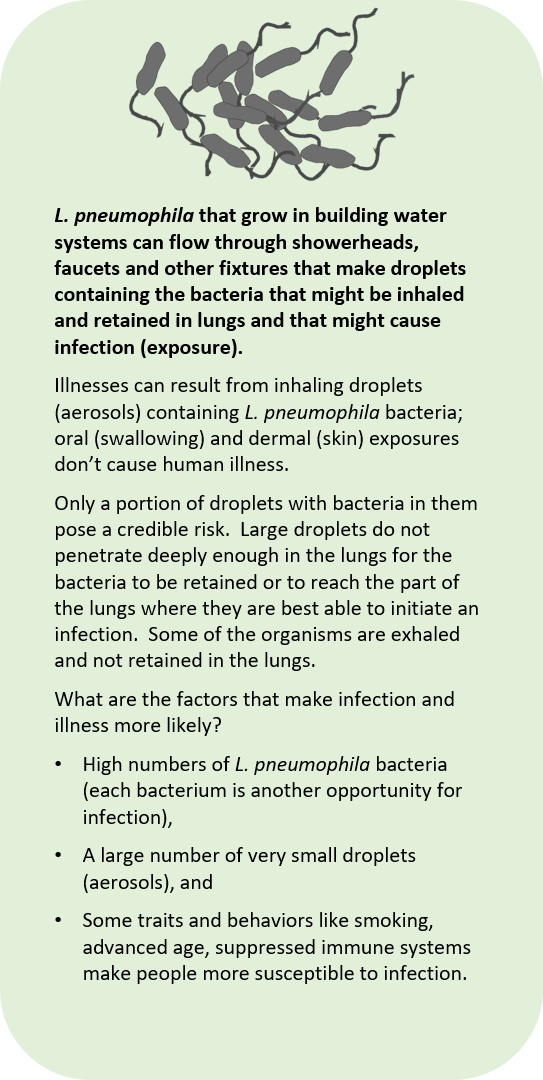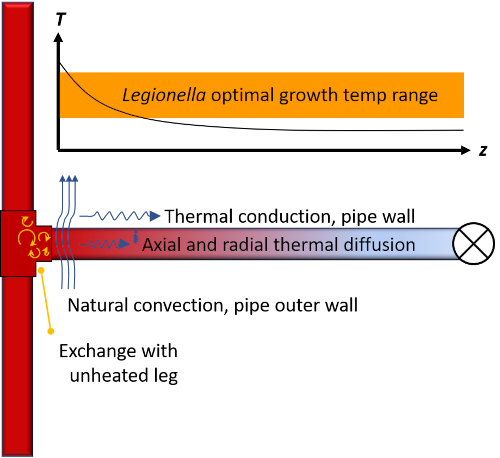
Reducing Legionnaires' Disease Risk Takes a Partnership
Public Water Systems
The panels below describe the sequence of events that result in exposures to Legionella bacteria from potable water systems. Because Legionella are environmental bacteria (bacteria that can grow in the environment without hosts) and because Legionella is suited for survival in treated drinking water, studies have shown that Legionella bacteria are often present in drinking water supplies, though usually at very low numbers. As a partner in managing Legionnaires' disease risk, public water systems can treat and manage their water to reduce the likelihood that Legionella bacteria are present at high numbers, but in most cases they cannot eradicate them.
Building Owners and Building Water System Operators
If water with low numbers of Legionella bacteria get into a building water system, conditions can be much better for the bacteria to grow to numbers that make infection more likely. Water in building water systems is no longer under the control of water supplier; it is the responsibility of the building owner and (for large buildings) the staff who maintain and operate the water systems. So, building owners and water system operators are the second partners in Legionnaires' Disease risk management. There are many actions that can reduce the likelihood the Legionella bacteria grow to risky populations and the best approach for making sure the right actions are taken is to develop and implement a Water Management Program. The US Centers for Disease Control and Prevention water management program toolkit ( Toolkit: Developing a Water Management Program to Reduce Legionella Growth and Spread in Buildings ) is a good resource for developing and sustaining a water management program.
The Public Health Community
The third critical partner in Legionnaires' disease risk management is the public health community. Public health officials track Legionnaires' disease and epidemiologists research Legionnaires' disease cases and outbreaks to determine the source. The public health community also has a limited degree of oversight for water systems of health care facilities and, in some communities, has programs for managing Legionnaires' disease risk from cooling towers. Cooling towers are separate from building potable water systems and have been identfied as the source of pathogens in some large recent outbreaks.




ESPRI as a Legionnaires' Disease Risk Management Partner
Is it Time for a New Certification for Staff who Operate the Buildings with Water Systems Designated Public Water Systems?
In some states, some building water systems are regulated as public water systems (PWSs) because they meet criteria such as conducting on-site supplemental water disinfection. One of the many requirements of PWSs is that they must be operated by a certified operator. For now, the only operator certifications available are for drinking water treament operation. This seems like a mismatch, since the knowledge, skills and abilities associated with running a building water system are different from those needed to run a treatment system. That mismatch could mean too few operators available to operate building water systems or it could mean drawing certified operators away from treatment plants. The drinking water industry already has concerns about loss of skilled staff as the "grey tsunami" of retirements rolls over the industry. The mismatch in building operator certification also means that building operators do not necessarily have the knowledge, skills and abilities approporiate for effectively running a building water system.ASDWA (The Association of State Drinking Water Authorities) asked ESPRI to write a white paper exploring whether a new certification specific to building operation is needed and, if so, what knowledge, skills and abilities would certified operators need. ESPRI's report ( ASDWA Building Operator White Paper) supports development of a new certification. Since publication of the report, Professionals in the American Water Works Association "Beyond the Meter" Premise Plumbing Subcommittee have continued to explore the need for a new certification and the process for developing the new certification. Early discussions support developing a range of operations for building operator certification inlcuding a new certification for staff operating buildings designated as PWSs, certifcate programs for other buildings and developing manuals of best practice for others.
If you have ideas about building operator certification, we'd like to hear about them. Please email us your thoughts (espri@esprinstitute.org).
Collateral Heating and Legionnaires' Disease
As seen in the diagram of a branch from a hot water recirculation loop, pipes with hot water can heat up water in non-flowing connected pipes and fixtures. This can maintain temperature in segments of a hot water systems in the ideal growth range for Legionella for extended periods. Branches off hot water recirculation loops, disharge lines from water heaters that are not recirculated, and hot water branches from frequently used main branches heating the water in infrequently used branches are all examples of common parts of hot water systems with collateral heating. Collateral heating causes both energy loss/waste and the potential for creating hazardous conditions that promote Legionella growth. Insulating hot water pipes can make matters worse by extended the length of the unheated leg with temperature in the ideal range for Legionella growth.
Research studies have not established whether collateral heating is a primary cause of ongoing Legionella contamination in hot water systems. Until such studies are done, a conservative approach is to identify locations with collateral heating as part of water safety planning and to consider adding controls if routine Legionella monitoring indicates contamination in branches with collateral heating. Controls that could be used to address collateral heating are more frequent flushing, periodic thermal disinfection with flushing, or periodic or continuous chemical disinfection.
ESPRI is developing opportunities for studying this potential problem and we are interested in your thoughts. Is this a priority problem? Are there novel ways to address it? Please email us your thoughts (espri@esprinstitute.org).

ESPRI - The Environmental Science, Policy and Research Institute - is a not-for-profit
organization dedicated to public health protection, water conservation and energy conservation.
Our specialty is water quality and our focus is building water systems.
Contact us at espri@esprinstitute.org
Last page update 24 Feb 2021